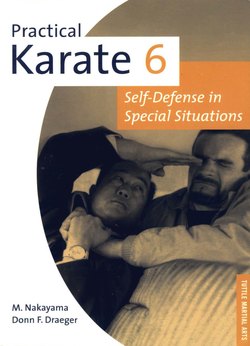Читать книгу Practical Karate Volume 6 - Donn F. Draeger - Страница 6
На сайте Литреса книга снята с продажи.
ОглавлениеAUTHORS' FOREWORD
THERE is perhaps no greater disservice to man than the creation of false confidence in his ability to defend himself. Whether this false confidence is manifested in his nation's armed might, or his own personal ability, the result is the same, though of different proportions, when tested—disaster!
The current karate boom in the U.S.A. has instilled in many would-be experts a serious, false sense of security. This is the natural outgrowth of a human psychological weakness. Everyone wishes to be physically fit and able to defend himself and his loved ones from danger and quickly turns to any sure-fire guarantee of such abilities.
Unscrupulous and unqualified self-appointed karate "experts" daily exploit this human weakness and prey on an innocent, unsuspecting public. This grossly perpetrated fraud is based on the quick learning of ancient mysterious Oriental combative forms such as karate, and almost always makes its appeal colorful through the use of adjectives such as "super," "destructive," "terror tactics," and guarantees you mastery of an art that will make you "fear no man." All such get-skillful-quickly schemes should be carefully investigated before taking them seriously, for true karate involves constant dedication to training and is never a short-course method. Choose your instructor carefully.
On the other hand, authentic teachers of karate do exist in the U.S.A., and their teachings have full merit. These teachings are deeply rooted in traditional, classical karate and require a liberal application of patience and regular training to develop expert karate skill. There are various schools that stem from historic Oriental antiquity, all of which are legitimate and have both merits and shortcomings. The choice of which school to follow can be decided upon only by the interested party.
The average person is confined to a daily life that requires of him a heavy investment in time and energy in order to earn a living. Leisure time is generally at a minimum and it is spent at less enervating pursuits than classical karate practice, a demanding and rigorous "pastime." But the need for a practical system of self-defense designed for the average person is more evident than ever before. Police files give mute testimony to the increasing number of robberies, assaults, and other vicious crimes.
In self-defense situations involving assailants armed with extremely dangerous weapons or those situations which are unusual due to circumstances of one's physical location or because of the nature of the method the assailant or assailants are using, each situation involves and carries with it a degree of danger beyond normal attack circumstances. Accordingly, karate techniques must be learned thoroughly and executed as automatic responses to any series of happenings if serious injury or death is to be avoided.
Like its predecessors—Books One, Two, Three, and Four—this book is a categorized collection of self-defense situations and recommended karate responses. It is written for every male person and brings to him a chance to improve his personal self-defense abilities without engaging in the severe discipline and dedication to daily training required by classical karate. It is not an exhaustive survey of karate methods, but it contains methods that give direct consideration to easy learning for the average person. All methods described in this book are workable karate self-defense responses based on meeting single and multiple assailants. The responses are simplified, direct methods of self-defense. If you have already studied and practiced the necessary karate fundamentals found in Book One of this series, the situations in this volume will be easier to learn. Otherwise, after reading about the situations and responses herein you may find it necessary to turn to Book One, the fundamentals book, and find the necessary movements and practice exercises that are required to make these responses work effectively.
On the other hand, authentic teachers of karate do exist in the U.S.A., and their teachings have full merit. These teachings are deeply rooted in traditional, classical karate and require a liberal application of patience and regular training to develop expert karate skill. There are various schools that stem from historic Oriental antiquity, all of which mere reading and one or two rehearsals of each response in this book will not produce effectiveness.
The authors are indebted to the Japan Karate Association for the use of their facilities and hereby acknowledge with pleasure the assistance of those members and officials who have made this book possible. Additional thanks are due to Y. Jinguji, whose excellent photographic skills have contributed greatly toward the easy readability of this book; to William A. Fuller, Paul Nutio, Dave Jinks, and Charles Gauch, who posed as "assailants," and to Mr. and Mrs. Frank P. Kreiger, Jr. of Tokyo whose private facilities served as background for many of the situations.
| Tokyo, Japan |
